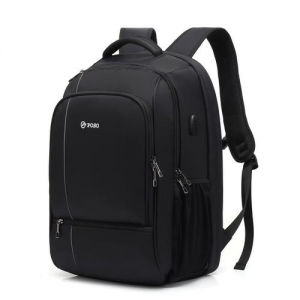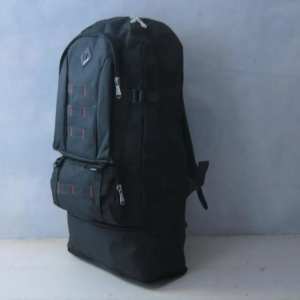
Backpack material testing part: It is to test the product's fabrics and accessories (including fasteners, zippers, ribbons, threads, etc.). Only those that meet the standards are qualified and can be used in the production of large quantities of goods.
1. Backpack fabric testing: The color, density, strength, layer, etc. of the fabric are all based on the samples provided. The raw materials of fabrics generally used on backpacks are Nylon and Poly, and occasionally the two materials are mixed together. Nylon is nylon and Poly is polyethylene. Newly purchased materials must first be inspected by a fabric inspection machine before they can be put into storage. Including testing the color, color fastness, number, thickness, density, strength of warp and weft yarns, as well as the quality of the layer behind, etc.
(1)Testing the color fastness of the backpack: You can take a small piece of fabric, wash it and dry it to see if there is any fading or color difference. Another relatively simple method is to use a light-colored fabric and rub it repeatedly. If the color is found to be stained on the light-colored fabric, the color fastness of the fabric is unqualified. Of course, special materials require special methods to detect.

(2) Color: Generally the color specified.
(3) Density and strength detection of warp and weft yarns of backpack fabric: use the most basic method, use both hands to stretch the fabric in different directions. If the fabric tears, it will obviously move closer to one direction. If this will directly affect Consumer use. We need to be clear that if we find obvious defects in the fabric during mass production (such as yarn picking, jointing, spinning, etc.), the cut piece cannot be used for the following assembly operations and must be replaced in time. Lose.
1. Testing of backpack accessories:
(1) Backpack fasteners: a. Inspection of buckles:
① First check whether the internal material of the buckle is consistent with the specified material (the raw material is usually Acetal or Nylon)
②Testing method for backpack fastness: For example: 25mm buckle, fixed with 25mm webbing on the upper side, 3kg load-bearing on the lower side, 60cm in length, lift the load-bearing object up 20cm (according to the test results, corresponding test standards are formulated) Drop it again for 10 consecutive times to see if there is any breakage. If there is any breakage, it will be deemed unqualified. This requires the development of corresponding standards for testing based on different materials and buckles of different widths (such as 20mm, 38mm, 50mm, etc.). It should be noted that the buckle needs to be easy to insert and unplug, making it easy for consumers to use. Similarly, for those with special requirements, such as buckles printed with logos, the quality of the printed logos must also meet the specified requirements.
b. Detection of sun-shaped buckles, rectangular buckles, stall buckles, D-shaped buckles and other fasteners: Sun-shaped buckles are also called three-stop buckles and are a commonly used material on backpacks. The raw materials are generally Nylon or Acetal. It is one of the standard accessories on backpacks. Generally, there will be one or two such buckles on backpacks. Generally used to adjust webbing.
Key points of inspection: Check whether the size and specifications meet the requirements, check whether the internal composition materials are consistent with the required materials; whether there are too many burrs on the outside.
c. Testing of other fasteners: Corresponding standards can be formulated according to specific circumstances.
(2) Backpack zipper inspection: Check whether the width and texture of the zipper are consistent with the specified requirements. For some models that do not have high requirements on facing, the zipper cloth and the slider are required to be pulled smoothly. The quality of the slider must meet the standard. The pull tab must not be broken and must be properly closed with the slider. It cannot be pulled off after a few pulls.
(3) Backpack webbing inspection:
a. First check whether the internal material of the webbing is consistent with the specified material (such as nylon, polyester, polypropylene, etc.);
b. Check whether the width of the webbing meets the requirements;
c. Whether the texture of the ribbon and the density of horizontal and vertical wires meet the requirements;
d. If there are obvious yarn picks, joints, and spinning on the ribbon, such ribbons cannot be used in the production of bulk goods.
(4) Backpack online detection: generally includes Nylon line and Poly line. Among them, Nylon refers to the texture, which is made of nylon. It looks smooth and bright. 210D represents fiber strength. 3PLY means that a thread is spun from three threads, which is called triple thread. Generally, nylon thread is used for sewing. Poly thread looks like it has many small hairs, similar to cotton thread, and is generally used for knotting.
(5) Testing of foam on backpacks: Foam plays an important role in backpacks. The materials collectively called foam can be divided into four types.
PU is what we often call a sponge, which has many pores and can absorb water. Very light, bulky and soft. Generally used close to the user's body. PE is a plastic foam material with many small bubbles in the middle. Light and able to maintain a certain shape. Generally used to hold the shape of a backpack. EVA, it can have different hardnesses. The flexibility is very good and can be stretched to a very long length. Almost no bubbles.
Inspection method: 1. Check whether the hardness of the foam produced in bulk is consistent with the final confirmed sample foam;
2. Check whether the thickness of the sponge is consistent with the confirmed sample size;
3. If some parts need to be composited, check whether the quality of the composite is good.
Post time: Dec-12-2023





